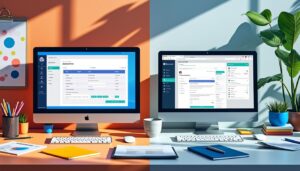Faced with increasing market volatility, companies must adopt innovative tools to manage their expenses. The digital twin of expenses is emerging as a key solution, providing an accurate and dynamic representation of costs. In this article, we will explore how this technology is revolutionizing procurement management in times of economic uncertainty.
Understanding the Digital Twin of Expenses
The concept of a digital twin refers to a virtual replica of a physical process, here applied to the area of expenses. By integrating real-time and historical data on raw material costs, the digital twin allows for the analysis of market trends and the prediction of price fluctuations. It thus provides companies with a clear overview of their spending structure, facilitating strategic decision-making.
Key Features of the Digital Twin of Expenses
The functionalities of this digital tool are varied, aimed at optimizing cost management and improving supplier relationships. Key features include:
- Predictive Analytics: Anticipates cost variations based on market trends.
- Scenario Modeling: Simulates different spending scenarios to help inform decision-making.
- Data Visualization: Provides graphical representations of spending and its trends to facilitate understanding.
- Data Integration: Gathering information from various sources to gain a comprehensive view of supplier costs.
Business Application Examples
To illustrate the impact of the digital twin of spending, let’s take the example of a manufacturing company. Using this technology, it was able to track rising steel prices due to geopolitical tensions. Through scenario modeling, it identified alternative suppliers and adjusted its purchasing methods accordingly.
Another telling example is that of a cosmetics company that, thanks to better visibility into its raw material costs, was able to negotiate more advantageous prices with its suppliers, based on tangible data. This enabled the company not only to reduce costs but also to plan more effectively by taking into account fluctuations in ingredient prices on the market.
| Feature | Description |
|---|---|
| Predictive Analytics | Anticipation of future costs based on historical data. |
| Scenario Modeling | Simulation of different spending configurations. |
| Data Visualization | Charts and tables to facilitate understanding of spending. |
| Data Integration | Consolidation of information from multiple sources. Implementation Challenges |
Adopting a digital twin of spending is not without its challenges, however. Companies still face several obstacles that can hinder their ability to fully leverage this technology.
Integration Complexity
Implementing a digital twin often requires complex integration with existing systems. Companies must ensure that the transferred data is reliable and consistent. This often requires the support of major technology players such as Microsoft, IBM, or SAP, who can provide tailored solutions.
Data from different departments can be disparate and require standardization. Collaboration between technical and management teams is therefore essential to overcome these obstacles. Team TrainingAnother major challenge is user training. Employees must be trained on how to use the digital twin to maximize its benefits. A common approach is to create pilot teams. These teams test the tool’s functionality before large-scale deployment. For example, some companies have implemented initial training sessions followed by regular seminars to ensure continuous learning.User Engagement: Involve employees in the adoption process.Ongoing Training:
Schedule regular workshops on new features.
Technical Support:
Establish support teams to answer user questions.
Challenge
- Description Integration Complexity
- Alignment of internal information systems. User Training
- Support teams in technology adoption. Initial Cost Budget assessments for investing in new technologies.
| Impact on Supplier Relationships | Creating a digital twin of spend also transforms the dynamics of buyer-supplier relationships. This new technology enables more informed negotiations and the establishment of strategic partnerships. |
|---|---|
| Improved Transparency | The digital twin provides an overview of pricing structures and associated costs, providing buyers with security in their negotiations. Thanks to increased transparency, companies can discuss matters more honestly with their trading partners, thus establishing a climate of trust. |
| Online communication tools integrated into digital twin platforms facilitate the exchange of information and updating of parameters in real time, thereby facilitating continuous cooperation between parties. | Trading Strategies Based on Hard Data |
| With the accessibility of market data, companies are equipped to negotiate contracts on factual rather than speculative grounds. This encourages suppliers to be more competitive, especially during periods of price fluctuations. | Buyers can also use simulations to evaluate the impacts of various trading strategies. For example, by changing volume or delivery time parameters, they can evaluate how these adjustments would affect overall costs. |
Use of concrete data:
Basing negotiations on quantitative analyses.
Achieving beneficial agreements:
Creation of win-win solutions for both parties.
Continuous assessment:
Adjustment of agreements based on new market data.
Impact
Example
- Increased transparency Sharing pricing structures between buyers and suppliers increases trust.
- Informed negotiations Use of simulations to adjust contractual conditions.
- Strategic partnerships Strengthened cooperation thanks to the visibility of agreements.
| Towards a sustainable future thanks to the digital twin | As businesses strive to become more sustainable, the digital spend twin offers crucial support when it comes to resource efficiency. By optimizing expenses, it becomes possible to reduce the carbon footprint. |
|---|---|
| Carbon footprint analysis | Companies can assess the environmental impact of each spending category. For example, by identifying carbon-intensive raw materials, buyers can direct their decisions toward more sustainable suppliers, thereby reducing their environmental footprint. |
| Life cycle analysis tools can be integrated into digital twins, helping to visualize the environmental impact of spending choices. | Sustainability Reporting |
| Furthermore, the digital twin enables the generation of automated reports that help companies comply with sustainability standards. These reports, based on real-time data, ensure transparency in environmental actions. | Sustainability Goals: |
Align spending with the company’s environmental objectives.
Supply Chain Optimization:
Promote sustainable suppliers.
Automated Reporting:
Centralize data for increased transparency.
Innovative Aspect
Positive Impact
- Carbon Footprint Analysis Reduce costs and environmental impact. Sustainability Reporting
- Increase transparency and improve corporate image. Supplier Optimization
- Strengthen responsible purchasing practices.


 Articles à découvrir aussi
Articles à découvrir aussi

